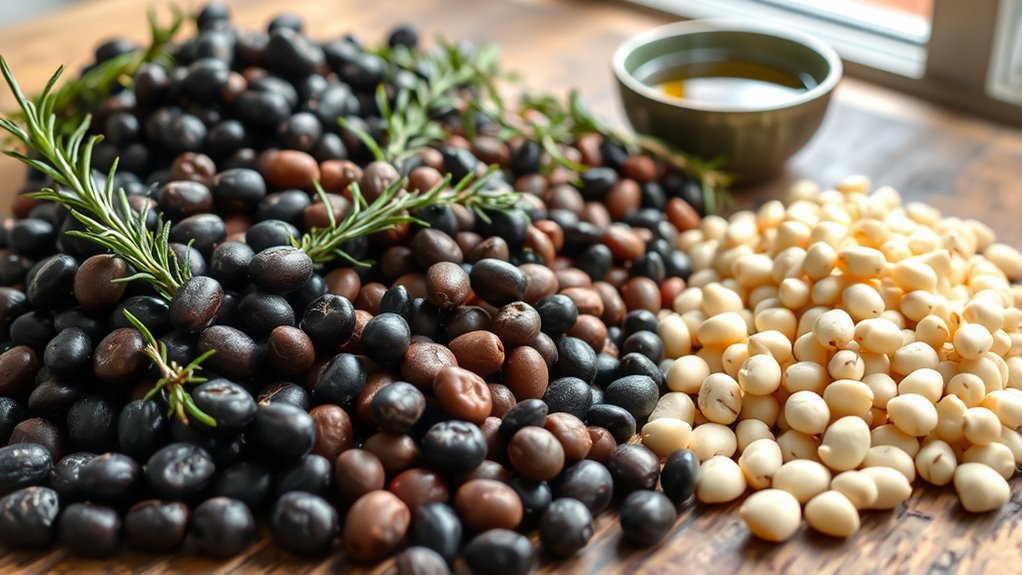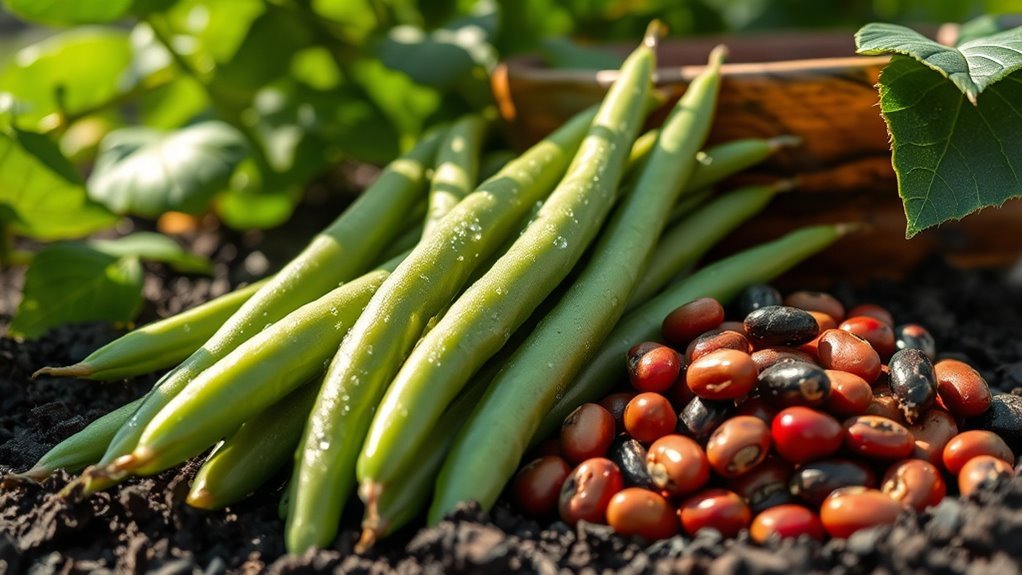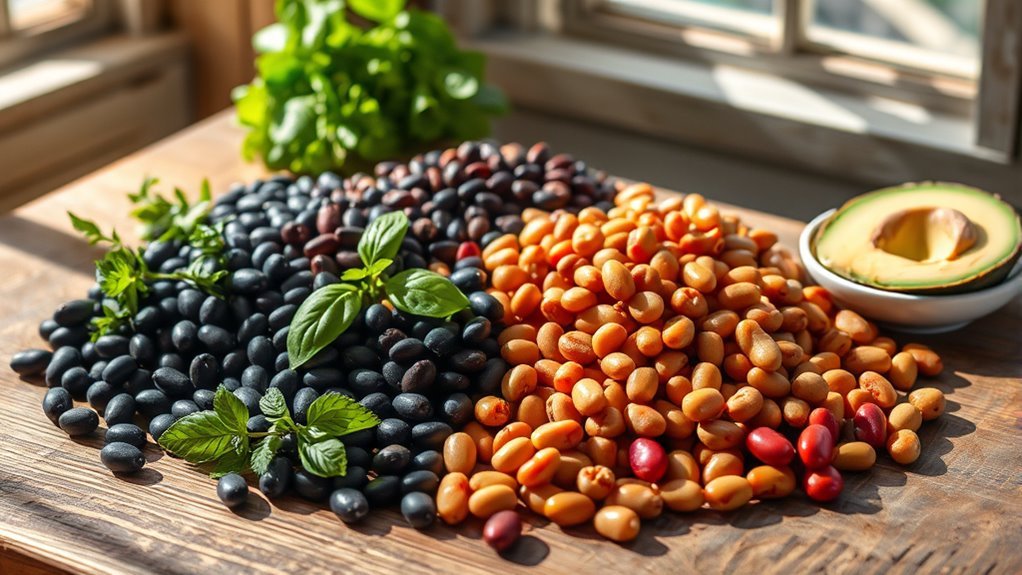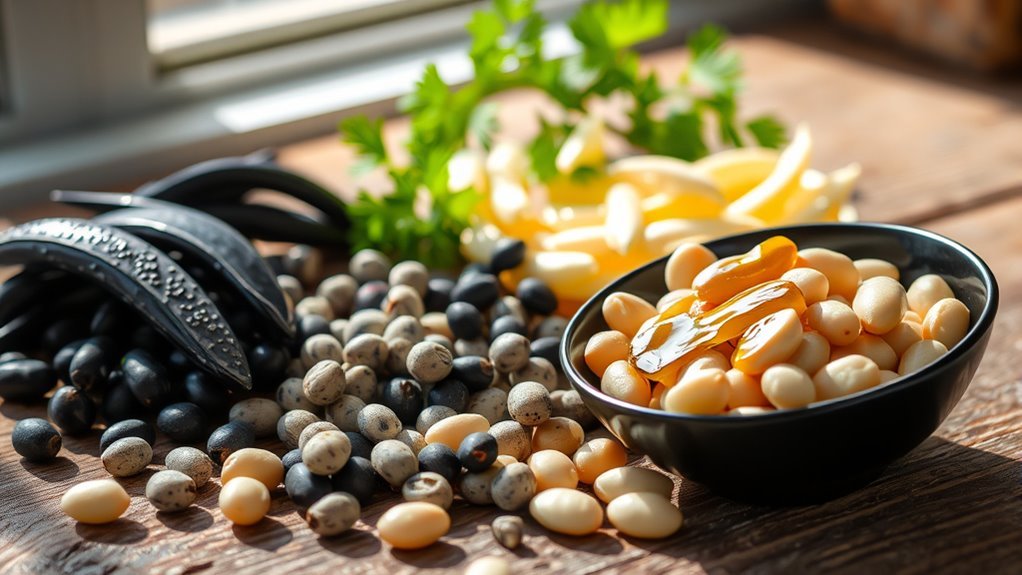Beans aren’t typically seen as keto-friendly due to their higher carbohydrate content, which can disrupt ketosis. However, if you choose lower-carb options like black soybeans or green beans and monitor your portions, you can incorporate them into your diet. Beans offer essential nutrients and fiber but should be paired with healthy fats for balance. With careful planning, you can enjoy the benefits of beans while staying within your carb limits. Discover more ways to manage your intake effectively.
Understanding the Ketogenic Diet

While many diets focus on calorie counting or food restrictions, the ketogenic diet offers a unique approach by emphasizing high-fat, low-carbohydrate intake to shift your body into a state of ketosis. This metabolic state enables your body to burn fat for energy instead of carbs, which can lead to weight loss. However, there are several ketogenic misconceptions that might confuse you. For instance, not all high-fat foods are beneficial, and individuals may experience different diet variations based on their unique needs and goals. Understanding these aspects can empower you to adopt a keto lifestyle that feels freeing rather than restrictive. By recognizing the nuances of the ketogenic diet, you can make informed choices that support both your health and personal freedom.
Nutritional Profile of Common Beans

Understanding the ketogenic diet’s emphasis on low-carbohydrate intake naturally leads to questions about foods that might not fit the traditional mold, such as beans. When examining common bean varieties, you’ll find they offer a unique nutritional profile. Beans are rich in protein content, providing a plant-based protein source that can complement your diet. For example, black beans and kidney beans contain around 15 grams of protein per cooked cup. Additionally, beans are packed with vitamins, minerals, and fiber, making them a nutritious option. However, their carbohydrate content can be higher than other keto-friendly foods. Balancing your intake of beans while considering their nutritional benefits is essential for those pursuing a ketogenic lifestyle.
Carbohydrate Content in Beans

If you’re considering adding beans to your ketogenic diet, it’s important to look closely at their carbohydrate content. While beans can be nutritious, different bean varieties have varying carbohydrate sources that could affect your daily intake. Here’s a quick overview:
| Bean Variety | Carbohydrates (g) per 100g |
|---|---|
| Black Beans | 23.7 |
| Kidney Beans | 22.8 |
| Pinto Beans | 27.1 |
| Chickpeas | 27.4 |
| Lentils | 20.1 |
You can see that some beans pack in more carbs than others. If you’re aiming to stay within your carb limit, it’s important to choose wisely and consider portion sizes when including beans in your meals.
The Role of Fiber in a Ketogenic Diet
When following a ketogenic diet, understanding the role of fiber is essential for your digestive health and overall well-being. Fiber comes in two types: soluble and insoluble, each offering distinct benefits that can help manage hunger and maintain gut health. Incorporating fiber-rich foods, even in moderation, can enhance your keto experience while supporting your body’s needs.
Fiber Types Explained
While many people associate fiber primarily with digestive health, its role in a ketogenic diet is equally significant. Understanding the two main types of fiber can help you make informed choices:
- Soluble Fiber: This type dissolves in water and can help regulate blood sugar levels, making it beneficial for those on a keto diet. It’s found in foods like avocados and chia seeds.
- Insoluble Fiber: This type doesn’t dissolve in water and adds bulk to your stool, promoting regularity. You’ll find it in vegetables and nuts, which can enhance your keto meal plan.
- Benefits of Both: Incorporating both types of fiber can support overall health while keeping you in ketosis, allowing you to enjoy the freedom and flexibility of a ketogenic lifestyle.
Benefits of Fiber
Fiber plays a pivotal role in a ketogenic diet, offering numerous health benefits that can enhance your overall well-being. It’s essential for maintaining digestive health, preventing constipation, and promoting a healthy gut microbiome. Plus, fiber can help you feel fuller longer, aiding in appetite control.
Here’s a quick overview of fiber’s benefits:
| Benefit | Description |
|---|---|
| Digestive Health | Supports regular bowel movements |
| Blood Sugar Control | Helps stabilize blood sugar levels |
| Heart Health | Lowers cholesterol and blood pressure |
Incorporating fiber-rich foods can empower your keto journey while ensuring you enjoy the freedom of a balanced diet. So, don’t overlook the importance of fiber in your meals!
Low-Carb Bean Alternatives
If you’re looking to reduce carbs while still enjoying the texture of beans, cauliflower and zucchini can be excellent alternatives. Cauliflower can be riced or mashed to mimic the consistency of beans, while zucchini can be spiralized or diced to add bulk to your dishes. Both options provide low-carb benefits without sacrificing flavor or nutrition.
Cauliflower as Substitute
As you explore low-carb options on a keto diet, cauliflower emerges as a versatile substitute for beans. It’s low in carbs and can be transformed into various textures and flavors. Here are three ways you can enjoy cauliflower in place of beans:
- Cauliflower Rice: Use grated cauliflower as a grain alternative, perfect for stir-fries or as a base for your favorite dishes.
- Cauliflower Mash: Blend steamed cauliflower with butter and seasoning for a creamy, low-carb side that mimics mashed potatoes.
- Cauliflower Tacos: Roast cauliflower florets with spices, and serve them in lettuce wraps for a tasty taco night option.
Zucchini Bean Replacement
While beans are often a staple in many diets due to their protein and fiber content, zucchini serves as an excellent low-carb alternative for those following a keto lifestyle. Zucchini nutrition is impressive; it’s low in calories and carbs while providing essential vitamins and minerals. When cooked, zucchini mimics the bean texture, offering a satisfying bite that can enhance various dishes. You can spiralize it for pasta, sauté it for stir-fries, or roast it to add depth to salads. By replacing beans with zucchini, you can enjoy flavorful meals without compromising your carb limits. This versatility not only keeps your meals exciting but also supports your health goals, giving you the freedom to explore delicious, low-carb options.
Enjoying Beans in Moderation
Although beans are often viewed as a staple in various diets due to their nutritional benefits, enjoying them on a keto diet requires a balanced approach. To make the most of bean varieties while maintaining ketosis, consider these tips for portion control:
- Choose wisely: Opt for lower-carb beans like black soybeans or green beans instead of higher-carb options like chickpeas.
- Watch your portions: Stick to small servings, as even the best bean varieties can add up in carbs quickly.
- Pair with fats: Combine beans with healthy fats, like avocado or olive oil, to create a satisfying meal that aligns with your keto goals.
Impact of Beans on Ketosis
Understanding the impact of beans on ketosis is crucial for anyone following a keto diet, since these legumes can greatly affect your carbohydrate intake. While some bean varieties, like black soybeans, can be lower in carbs and may fit into your keto plan, others, such as kidney beans and chickpeas, are higher in carbohydrates and can hinder your ketosis effects. Consuming too many carbs from beans could push you out of ketosis, making it essential to monitor your portions. If you love beans, it’s important to choose wisely and consider their carb content. Balancing your bean intake with other low-carb foods can help maintain your desired state of ketosis while still enjoying the nutritional benefits beans offer.
Tips for Incorporating Beans Into Your Diet
If you’re looking to incorporate beans into your keto diet without compromising your carb limits, there are several strategies you can use. Here are three effective tips:
- Meal Prep: Cook beans in bulk and portion them out for the week. This way, you’ll have controlled servings ready to go, making it easier to manage your carbs.
- Choose Wisely: Opt for lower-carb beans like black soybeans or green beans. They provide fiber and protein without tipping your carb scale too high.
- Mix and Match: Combine beans with low-carb veggies or healthy fats to enhance flavor and nutritional value while keeping your meals balanced.


